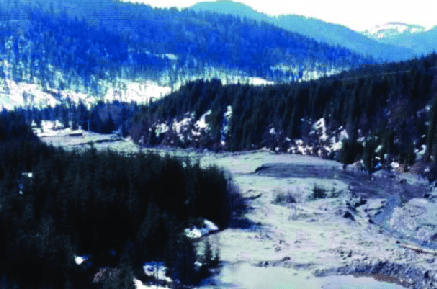Der Einsturz der Deponie von Baia Borsa, 2000
Deutscher Text nicht vorhanden
On 10th March 2000 torrential rains (37 litres/m2 according to a local weather station) and melting snow from the slopes surrounding the Novat artificial reservoir at a mine in Baia Borsa, Maramures region, Romania, led to an unmanageable rise in the reservoir’s water level.
At about 11:00 a.m. on 10th March, approximately 20,000 tonnes of mineral waste was flushed into the River Viseu from the decantation reservoir of the Baia Borsa Preparation Enterprise mine.
The waste been stored following the processing of complex ores of lead, copper and zinc.
The accident led to pollution of the River Vaser with minerals and heavy metals.
This river is a tributary of the River Tisza that flows through the Ukraine and Hungary.
On 11th March 2000 the Hungarian authorities appealed to the Joint United Nations Environmental Programme (UNEP) and the Office for the Coordination of Humanitarian Affairs (OCHA) Unit to provide urgent assistance in the form of independent sampling and analysis.
The incident was the second spill in the region within a month, the first being the pollution caused by contaminated water from the Aurel gold plant in Baia Mare in late January 2000.
The Baia Borsa Preparation Enterprise mining company produces copper, lead and zinc.
The ore in which the metals are embedded is milled and then separated from the metal.
The residue of this process is pumped through a pipeline to the small valley of Novat, 830 m a.s.l. where it is deposited.
The depot consists of a series of three connected ponds where the residue is separated from the water.
Under normal conditions, water from the lowest pond is pumped back into the first depot.
The uppermost pond, where the incident occurred, is about 100 m wide at the dam and approximately 400 m long.
The heavy rainfall of 10th March 2000, combined with melted snow descending from the slopes above, smashed a section of the dam built with sediment from the mine.
The residue from the separation process washed through the breach into the River Novat and subsequently into the Viseu.
From there it flowed through the Ukraine into Hungary and into the waters of the River Tisza.
The V-shaped breach in the dam was about 30 m long and 25 m high.
Polluted waters reached Ukrainian territory during the night of 10th March.
The “cyanide” spill in Baia Mare, which had taken place 5 weeks prior to the second mineral waste spill, had already had a negative impact on the River Tisza and the population living in the area.
The middle section of Lake Tisza is Hungary’s largest fishing ground.
It contains some fifty species of fish, twelve of which are protected.
According to reports released by Hungarian authorities, more than 1,200 tonnes of fish were killed in the cyanide spill; the total damage is estimated at US$ 4.1 million.
In addition, the fauna and flora of Hortobagy National Park were reportedly placed at risk by the “cyanide” spill.
The 55,000 hectares of alkaline, grassy lowland is home to some of the most unique wildlife and nature treasures in Europe.
The parkland surrounding Lake Tisza abounds in water lilies and fern, water chestnuts and willows.
Birds in the sanctuary on the northern shores of the lake feed on the fish and insects attracted by the water, as do countless migrant species.
The impact on the local economy has also been remarkable.
Fish consumption has decreased drastically not only in the disaster region, but also throughout Hungary.
A significant reduction in
tourism, a major economical factor in the area, has also occurred.
Indeed, more than 60 per cent of tourists in this area come to fish on the
River Tisza.
A number of factors contributed to this accident:
- deficiencies in the design of the system (tailings retention dam and metal treatment processes) at the Baia Borsa mine;
- deficiencies in the operation of the plant relating to precautions against overflows and spills, and in terms of emergency response plans;
- weak and inappropriate permitting of the facility, and inadequate monitoring and inspection.

